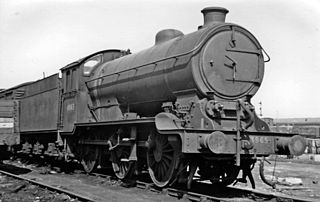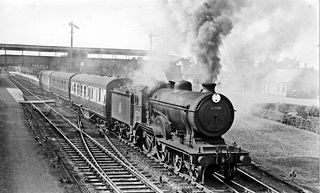
The steam locomotives of British Railways were used by British Railways over the period 1948–1968. The vast majority of these were inherited from its four constituent companies, the "Big Four".
The London and North Eastern Railway (LNER) produced several classes of locomotive, mostly to the designs of Nigel Gresley, characterised by a three-cylinder layout with a parallel boiler and round-topped firebox. It produced the most famous locomotive of its day, 4468 'Mallard', the holder of the world steam locomotive speed record. It also built the world-famous 4472 'Flying Scotsman'. However, its locomotive inheritance was much greater than just the 'A4 Class', it also produced highly successful mixed-traffic and freight designs.

The Great Northern Railway (GNR) Class J13, classified J52 by the LNER is a class of 0-6-0ST steam locomotive intended primarily for shunting.

The Great Eastern Railway (GER) Class Y14 is a class of 0-6-0 steam locomotive. The LNER classified them J15.

The London and North Eastern Railway (LNER) Class J39 was a class of medium powered 0-6-0 steam locomotive designed for mixed-traffic work throughout the former LNER system between London and the north of Scotland.

The North Eastern Railway (NER) Class H, classified as Class Y7 by the London and North Eastern Railway (LNER) is a class of 0-4-0T steam locomotives designed for shunting.

The GER Classes S46, D56 and H88 were three classes of similar 4-4-0 steam locomotive designed by James Holden and A. J. Hill (H88) for the Great Eastern Railway.

The GER Class G58 was a class of 0-6-0 steam tender locomotives designed by James Holden for the Great Eastern Railway in England. The class consisted partly of new locomotives built from 1905 to 1911 and partly of rebuilds of the earlier GER Class F48 built from 1900 to 1903. The rebuilding started under GER auspices from 1921 and was continued by the London and North Eastern Railway (LNER) after grouping in 1923.

The GER Class T26 was a class of 2-4-0 steam tender locomotives designed by James Holden for the Great Eastern Railway. At the 1923 grouping they passed to the London and North Eastern Railway, who classified them E4. Eighteen survived into British Railways ownership in 1948, and the last was withdrawn in 1959, making them the last 2-4-0 tender locomotives at work in Britain. Their BR numbers were 62780–62797.
Matthew Stirling (1856–1931) was Locomotive Superintendent of the Hull & Barnsley Railway (H&BR). Matthew Stirling was born in Kilmarnock on 27 November 1856. He was the son of Patrick Stirling, the nephew of James Stirling, and grandson of Robert Stirling – all of whom were also famous mechanical engineers.

The North Eastern Railway (NER) Class Y 4-6-2T tank locomotives were designed whilst Wilson Worsdell was Chief Mechanical Engineer, but none were built until 1910 by which time Vincent Raven had taken over.
The H&BR Class A was an 0-8-0 heavy freight engine designed by Matthew Stirling and built by the Yorkshire Engine Company of Sheffield. They were the largest of the engines on the Hull and Barnsley Railway. The Class A was developed to deal with the steeply graded eastern section of the H&BR between Springhead and Sandholme. Because of this the special link workings they dealt with were nicknamed the "Sandholme Bankers".
The H&BR Class F3 was a class of 0-6-2T steam locomotives of the Hull and Barnsley Railway. They were designed by Matthew Stirling to work goods trains to and from the King George Dock at Hull which opened in 1914. They were not fitted with vacuum brakes so they were not suitable for passenger work.
The H&BR Class F1 was a class of 0-6-2T steam locomotives of the Hull and Barnsley Railway. The locomotives were part of a batch built by Kitson and Company for the Lancashire, Derbyshire and East Coast Railway (LD&ECR), but the order was cancelled because the LD&ECR was unable to pay for them.

The H&BR Class G3 was a class of 0-6-0T steam locomotives of the Hull and Barnsley Railway (H&BR). The H&BR became part of the North Eastern Railway (NER) in 1922 and the NER became part of the London and North Eastern Railway (LNER) in 1923.

The GER Class M15 was a class of 160 2-4-2T steam locomotives designed by Thomas William Worsdell and built for the Great Eastern Railway between 1884 and 1909. The original (F4) class of locomotives were fitted with Joy valve gear which was notoriously difficult to 'set'. This earned them the nickname of 'Gobblers' thanks to their high coal consumption rates. As a result, between 1911 and 1920, 32 of them were rebuilt by James Holden with Stephenson valve gear and higher pressure boilers. Despite this, the nickname stuck for many years after.

The NBR S Class was a class of 0-6-0 steam locomotive designed by William Paton Reid for freight work on the North British Railway. The engines were initially designated as B class, being a development of the standard B class locomotives designed by Reid some eight years previously, and represented the culmination of a long evolution on the NBR of powerful 0-6-0 freight engines. The new locomotives were introduced in 1914 and had superheaters, inside cylinders and piston valves operated by Stephenson valve gear.

The Great Northern Railway J4 Class was a class of 322 0-6-0 steam locomotives, introduced in 1882 designed by Patrick Stirling for goods traffic. Just over half of these were rebuilt by Nigel Gresley to a design by Henry Ivatt between 1912 and 1929.
Locomotives of the Hull and Barnsley Railway. The Hull and Barnsley Railway never manufactured any of its own locomotives, all being built elsewhere. The first types in use were of the design W. Kirtley who was acting as a consultant. Matthew Stirling was the first and only Locomotive Superintendent of the H&BR during its independence, and he undertook the rebuilding of some of Mr. Kirtley's designs, as well as contracting the construction of his own designs to various builders. His locomotives were typically domeless, and many of the original Kirtley engines were also rebuilt without domes.

The GNR Ivatt Class 1 0-6-0 was a class of fifteen inside-cylinder 0-6-0s designed for express goods work. They were Henry Ivatt's first original class of 0-6-0. Ivatt had previously designed a modified version of Patrick Stirling's J5 Class of 1873.













